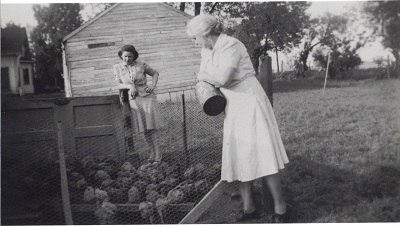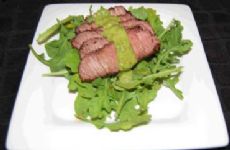|
Why did the chicken cross the road? To take a vacation from all the egg laying. Funny to me and you but not the chickens. When chickens first became domesticated animals, the only time you actually ate then was if a hen stopped laying eggs or on a holiday when no meat could be found. If you ate an egg-laying hen, you ate the business. My family has a long history of raising chickens for eggs. Back when my great-grandmother was raising hens, the birds--omnivores by nature--ate grain and roamed outside to peck for proteins in the form of bugs and worms. Times certainly have changed from Ma's day.  My cousin's daughter lives in a small town in England and started her own coop a couple of years ago at the tender age of 12. What success she has had with the egg production! I have pleaded with my dad, who is a farmer, to help me get started with raising some at our house in northern Kentucky. I feel like a child asking a parent for a dog. All I hear in response is that they are too much work, roosters are loud, and the worst--you will be so upset when a fox or hawk decides to eat them from supper. So for now, like most people, I pick up my eggs from the grocery store or at the farmers market. Since we all can't raise chickens for egg production, what should we as consumers look for when buying eggs? I buy an all-purpose egg, which is a grade A, size large egg. What that means is that the egg does not spread too much when place into a skillet to fry, the yolk is firm, and the shell is clean without cracks or blemishes. The chalazae, which is a cord that suspends the yolk in the center of the egg is prominent but not as large as in the Grade AA egg. Whether you choose brown or white eggs, it makes no difference. It varies based on the breed of chicken. Freshness is key, except when simmering eggs. OK, I can now hear everyone talking to their computers. "What? Is she crazy? What is a simmered egg, and why would a chef not want to use fresh eggs?" Well, I'm not crazy, at least not at this moment, according to my family. A simmered egg is what we know colloquially as a boiled egg. Do you often try to boil eggs and end up with cracked shells and a mess in your pot? Rapid boiling will crack the eggs in the cooking water before they are set. A simmer keeps the eggs in the shell until you're ready for the two to part ways. Speaking of eggs and eggshells, a slightly older egg will peel much easier than its fresher counterpart. Not only does boiling an egg often damage the shell, but it often causes that unsightly gray-green ring around the yolk from overcooking. The egg ends up tough and rubbery, too. The best way to cook an egg in its shell is to place your eggs in a saucepan of cold water. The water should cover the eggs by one inch. Bring the water to a simmer over medium-high heat, cover and set the pot aside for 15 minutes. The eggs will love this moist sauna and give you a set yellow yolk without any green layer between the yolk and the white. Prefer your yolks softer? Try the slow simmer method. Add enough water to a saucepan cover eggs by one inch, bring to a simmer over medium-high heat. The water should just be at a slow simmer, with tiny bubbles rising to the top of the water. Using a slotted spoon, carefully slide the eggs into the water. Cook 4-5 minutes for soft, runny yolks, or 7-8 minutes for a medium-set yolk. Drain the water from the saucepan, then shake the cooked eggs in the dry pan to crack the shell. Peel under running cold water. This is where the "older" egg helps you. Really fresh eggs are harder to peel because the air pocket inside is smaller. That's why a fresh egg will sink, a still-OK-to-eat egg will hover in the middle, and an old egg will float in a glass of water--that air pocket increases as the egg ages. How do you know if your eggs are set?
Eggs are egg-cellent anytime! I love to flip-flop meals, serving eggs for dinner instead of breakfast. Eggs are a fast, inexpensive, and nutritious way to add protein to your meals any time of day. You can keep it simple with a traditional egg meal or add seasonings, plenty of veggies and low fat meats and cheeses to the eggs. Try these simple dishes for your next evening meal, no recipe needed. Tired of plain boiled (simmered) eggs? Try my infused eggs for an added layer of flavor. They are great over salads, vegetables, or even as part of an antipasto platter. Vegetable Egg Strata: Layer thin slices of whole wheat bread, tomatoes, and leftover roasted vegetables in a casserole dish. Add egg whites, season with herbs and spices, and bake at 350 until the eggs are set. Bunny in a Hole: Cut two 1-inch holes in a slice of whole-wheat bread, spritz the bread with nonstick cooking spray then place in heat nonstick sauté pan to toast. Once the bottom is toasted, flip the bread, and add egg substitute, diced ham and cheese into the holes. Cook until the egg is set. If you want to make eggs a bit fancier, serve Chef Meg's Eggs Nested in Tomatoes. How to tell if your eggs are OK? How do you keep them safe?
More recipes and videos: Chef Meg's Deviled Eggs How to Make an Omelet How to Poach an Egg How to Tell If an Egg is Fresh What is your favorite breakfast-for-dinner egg dish? Want more healthy recipes from me and fellow SparkPeople members? Be sure to subscribe to SparkPeople's Recipe of the Day email. Click here to sign up! Did you know SparkRecipes is now on Facebook? Click here to "Like" us! Like this recipe? Then you'll love "The SparkPeople Cookbook: Love Your Food, Lose the Weight." |
More From SparkPeople
|










.jpg)











